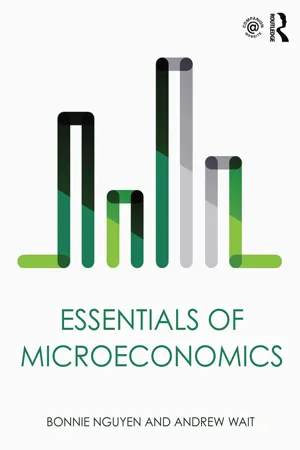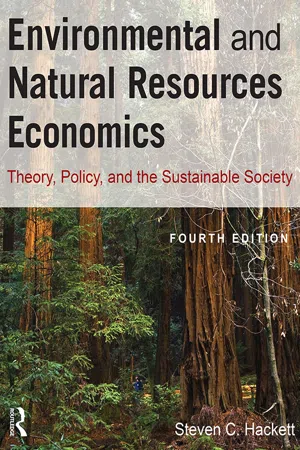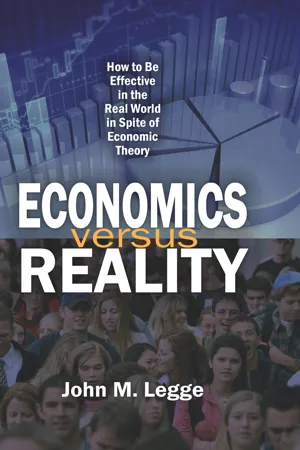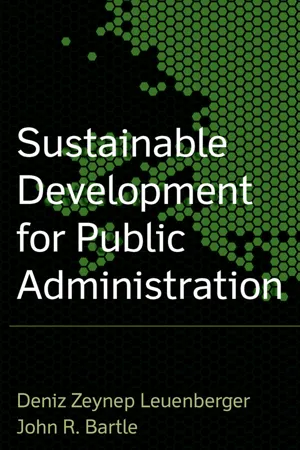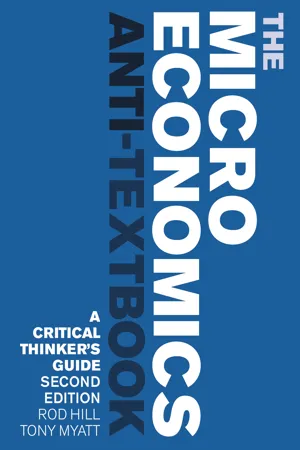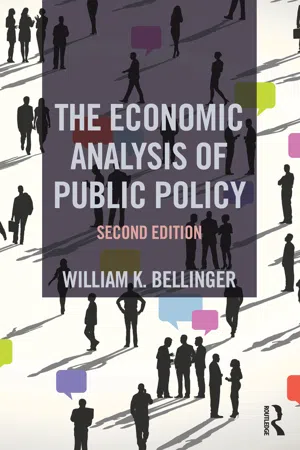Economics
Public Solutions to Externalities
Public solutions to externalities refer to government interventions aimed at addressing the impact of externalities, which are the spillover effects of economic activities on third parties. These solutions can include implementing taxes or subsidies to internalize external costs or benefits, establishing regulations and standards, and creating tradable permits systems. The goal is to align private incentives with social welfare and promote efficient resource allocation.
Written by Perlego with AI-assistance
Related key terms
Related key terms
1 of 4
Related key terms
1 of 3
10 Key excerpts on "Public Solutions to Externalities"
- No longer available |Learn more
- Bonnie Nguyen, Andrew Wait(Authors)
- 2015(Publication Date)
- Routledge(Publisher)
Again, in terms of dealing with an externality a government could opt to set a tax (a price to pollute) or it could set a quantity of permits and allow the price of the permits to be set in the market for permits. Notably, either option could achieve the same (efficient) outcome. For example, if the government implements a tradeable permits scheme with 100 permits and the price of a permit (to produce one unit of output) trades for $20, the government could alternatively get the same outcome instituting a tax of $20 per unit of output. Under either system, there is an extra $20 cost of producing output – either that cost is the cost of the permit or it is the cost of the tax. Thus, for every level of tradeable permits there is an equivalent tax that could implement the same outcome.17.6 Concluding comments
Externalities are a source of market failure because they represent costs and benefits that are not accounted for by the market. As a result, the market equilibrium that results from the private decisions of consumers and firms will not necessarily be the socially optimal outcome. There are a number of solutions to this problem. The Coase Theorem postulates that, if property rights are defined and there are no transaction costs, parties will privately negotiate to implement the socially optimal outcome. Failing this, there are also a number of government policies that can be used to correct externalities; these include taxes, subsidies, standards and tradeable permits.Notes
- By ‘mutually beneficial trades’ , we mean trades that can benefit both the buyer and the seller.
- Put another way , externalities can be thought of as ‘spill-over effects’ from economic activity.
- These taxes or subsidies are also caused ‘Pigovian taxes’ or ‘Pigovian subsidies’ , after Arthur Pigou who developed the concept of externalities.
- Note , this is an example of a tax that does not cause a DWL.
- As an example
- eBook - ePub
- Kazuhiko Mikami(Author)
- 2011(Publication Date)
- Routledge(Publisher)
13.1 Introduction
In the previous two chapters, we considered market power and asymmetric information as the causes of market failure, and examined their implications for the comparative efficiency among several types of private enterprises. In this chapter, we deal with externalities as the third major cause of market failure and explore how they influence the comparative efficiency of firms in different forms, particularly among several types of public (or government) enterprises. Through the analysis in this chapter, we demonstrate that economic efficiency can be improved by engineering the ownership structure of an enterprise not only in the private sector, as shown in the previous two chapters, but also in the public sector.We here consider externalities that are involved with public goods. Public goods are defined as goods and services that are nonrival and nonexcludable in consumption. Public goods give rise to a kind of consumption externality in the sense that benefits from the goods and services are not restricted to a certain individual but are spread to other individuals. For example, benefits from the police, fire departments, immunization, public hospitals, compulsory education, and public libraries diffuse over the entire population in the community or region.Because of the externalities that arise from their nonrival nature, public goods are undersupplied at best in the product market. In addition, if nonexcludability gives rise to free-riding, public goods may not be supplied at all in the product market. The market for public goods thus fails to achieve allocative efficiency, and this is why public goods are not usually supplied by capitalist firms. (Recall the discussion in Section 2 of the Overview, which implies that a capitalist firm would sell public goods to the consumers in the product market. We consider such a hypothetical situation in Supplementary Section 3.6 - eBook - ePub
Environmental and Natural Resources Economics
Theory, Policy, and the Sustainable Society
- Steven Hackett, Sahan T. M. Dissanayake(Authors)
- 2014(Publication Date)
- Routledge(Publisher)
Chapter 7 .Summary
- Positive externalities are unpaid-for benefits to society generated as a by-product of production and exchange. When there are important positive externalities, market demand based on the private benefits of buyers understates the full social benefits of the good or service generating the external benefit. Consequently, too little of the good or service generating the positive externality is produced in otherwise well-functioning competitive markets. Subsidies represent a form of policy intervention that can enhance market efficiency by internalizing the positive externality. Positive externalities can also affect the supply curve, such as when there are knowledge spillover externalities.
- While the legal system is designed to protect property, open-access and public trust resources were not traditionally protected under common law from pollution harms and thus remain subject to degradation. The legal system does not function perfectly, of course, and so pollution harms to people, their homes, and other valuable objects that are property do regularly occur. One problem is in determining the source of the pollution when there may be very large numbers of emitters, as is the case with automobile exhaust.
- Negative externalities are uncompensated damage costs borne by members of society. These negative externalities are generated as a by-product of production and exchange. Profit-maximizing firms have an incentive to transform private costs into negative externalities (external costs) in the absence of regulation or reputation effects. When there are important negative externalities, market supply based on private costs to sellers is too large, leading to too much of the good or service generating the negative externalities being produced in otherwise well-functioning competitive markets. Pigouvian taxes represent a form of policy intervention that can enhance market efficiency.
- eBook - ePub
Economics versus Reality
How to be Effective in the Real World in Spite of Economic Theory
- John Legge(Author)
- 2017(Publication Date)
- Routledge(Publisher)
Less ideological economists have observed that many transactions do inflict costs, or sometimes benefits, on third parties. Such costs or benefits are referred to as externalities. Neoliberal theorists argue that either there are no significant negative externalities, or if there are significant externalities, the costs inflicted by government action to rectify them would exceed the harm that they cause.Economists going back to Adam Smith1 have observed that there are some necessary services that cannot be provided by a market, or at best cannot be provided satisfactorily. Such services and institutions are referred to as public goods, since without them the majority of the population, and the aggregate population, would be worse off.Examining the real world shows that there are, in fact, many externalities arising in the normal course of the operation of a capitalist system, and there are many public goods that an unregulated market would not provide.Public Goods
A public good is one that is available to all the people in a community or to none of them; the classic example is “freedom from foreign invasion.” If one’s country is invaded and occupied, this affects all the residents: it is impossible for one household to be invaded and occupied by foreign enemies while its neighbors remain free of such problems. For this reason even the most ardent libertarians support the existence of national defense forces financed from general taxation.Mortality from disease was far higher in the nineteenth century than it is today, and life in the great cities was particularly unhealthy, with typhoid and cholera carrying off as much as 3 percent of the population in some years. While the poor suffered more than the rich, no one was immune: Queen Victoria’s consort, Prince Albert, died relatively young, probably of typhoid fever. Doctors had various explanations for illness and contagion, but it wasn’t until the work of Louis Pasteur in the 1860s that the germ theory of disease became established. Pasteur and those convinced by his arguments and demonstrations had to overcome the protests of the more conservative doctors who were unwilling to see their learning discredited and who resented the implication that their poor hygiene had killed many of their patients. - eBook - ePub
- Raghbendra Jha(Author)
- 2009(Publication Date)
- Routledge(Publisher)
4 External effects and the market mechanism DOI: 10.4324/9780203870044-4 Key concepts: externalities; market failure; the Coase solution; Pigovian taxation and subsidization; conditional perfect price discrimination; conditional perfect internalization; common property resources; multilateral externalities 4.1 Introduction In Part I we have examined the circumstances under which the market mechanism works efficiently. More specifically the second classical theorem of welfare economics, which was proved in Chapter 2, delineates these conditions. If such conditions did indeed obtain there would be no reason for government intervention in the working of the market mechanism. We realize, of course, that the conditions of this theorem are very stringent. In this chapter we relax one of these conditions and examine the implications for public policy. It has been implicit in our analysis so far that the preference ordering of any consumer is defined over her own consumption set. Similarly it has been assumed that the production set of any producer is independent of the production sets of other producers and consumption sets of consumers. In real life these assumptions are often violated and we have interdependence between production and/or consumption sets. When this occurs, an externality is said to exist. Formally, then, an externality is a commodity which is produced during the production and/or consumption of other goods and which affects other producers/consumers. When a paper mill dumps toxic waste into a river, thus contaminating the fish downstream, it affects the production sets of fishermen living downstream. When your neighbor plays loud music late at night when you are trying to sleep, he affects your consumption set and welfare - John R. Bartle, Deniz Zeynup Leuenberger(Authors)
- 2014(Publication Date)
- Routledge(Publisher)
The Wealth of Nations , first published in 1776 (1909). Therefore, an unsustainable system is not only bad for the environment, but also bad for the economy.ExternalitiesAs mentioned above, externalities are external costs or benefits of a transaction that affects others besides the two making the exchange. For example, you decide to plant a flower garden in your yard that I can see from my yard. You work hard to maintain the garden and pay all the expense. I enjoy the benefit of your consumption decision at no cost. This is a positive externality in consumption—positive because it is a benefit, and related to consumption because it is a consumption decision you make. A negative externality in consumption would be any decision you make that creates a cost or negative effect for me, such as playing music I do not like, smoking, driving a polluting car, or using hazardous chemicals in your yard that leak into mine. Externalities in production can be positive or negative too. The classic negative production externality is air or water pollution from manufacturing. An example of a positive externality is research by one company or university that can be used by another.As these examples illustrate, externalities are common occurrences in daily life. Some are minor and can be resolved easily. If your music is too loud, I can ask you to turn it down. If I enjoy your flowers, I can thank you by baking you cookies or helping you rake your leaves or shovel snow from your walk. A healthy fabric of society and a healthy set of economic institutions reinforce the resolution of many of these externalities. In other cases, they will not be resolved privately. A power plant polluting a river that flows through many states or provinces creates a complex problem that affects thousands, perhaps millions of people. The owners of the power plant will probably not want to make any changes in its production that increase its costs, and the people affected may be too disparate and unorganized to negotiate directly with the factory. Further, political and economic power may hinder the resolution of the problem. If the factory owners are politically and economically stronger than those harmed by the pollution, then the pollution may well continue.- eBook - ePub
The Microeconomics Anti-Textbook
A Critical Thinker's Guide - second edition
- Rod Hill, Tony Myatt(Authors)
- 2021(Publication Date)
- Zed Books(Publisher)
Chapter 7 Externalities, common access resources and public goods: the ubiquity of market failureInvisible hand; Mother of inflated hope, Mistress of despair!– Stephen Ziliak1In an address to the American Economic Association in 1972, Joan Robinson asked an inconvenient question: ‘In what industry, in what line of business, are the true social costs of the activity registered in its accounts?’2 The answer is ‘none’. Yet the default model of the textbooks assumes that producers of goods and services do pay the full social cost of production. Similarly, when someone buys a good or service, she pays the full cost as well. No one else experiences any costs (or benefits).If producers or consumers impose such ‘external’ costs (or confer ‘external’ benefits) on others and don’t take those into account in their decisions, the result would be an inefficient use of resources. The invisible hand drops the ball, yet again.The most obvious examples where both consumers and producers have been failing to pay the full social costs are the activities that contribute to climate change. The standard texts typically mention this issue in their chapter on externalities. Because of its critical importance, a Postscript chapter is devoted to this, examining the content of the texts and providing an anti-text critique. Unfortunately, as we will see, there is no shortage of other pervasive and serious externalities to consider.Included in this chapter are two other kinds of goods. External costs play a central role in the analysis of ‘common access resources’ such as water or wild fish, where people using the resource impose costs on others. The concepts of external benefits and costs also appear when considering ‘public goods’ (or ‘public bads’) to which everyone has free access and where no one’s use of the good (or bad) reduces others’ ability to consume it – for example, a quiet (or an unpleasantly noisy) street. - eBook - ePub
- Amal Sanyal(Author)
- 2017(Publication Date)
- Routledge(Publisher)
Relatively recently, a novel method for pollution control is being tried out around the world, notably in the US. It is best to illustrate it with an example. Suppose an industry consisting of a number of firms generates a polluting gas. The government can impose a tax on their output. But we know that this method does not provide the polluter with any incentive for adopting less-polluting technology. Taxes also do not discriminate between a small and a large polluter because the tax rate is uniform. Now consider this alternative. The government decides to sell a fixed number of ‘permits’ for pollution to this industry. One permit is needed for a specified amount of discharge. The government decides to allow a certain amount of discharge for the whole of this industry in a given year. It then calculates the total number of permits necessary for this and puts them on sale. At the start, firms have to buy the permits through auction. Later on they can buy or sell these among themselves in a secondary market. Because the supply of permits is fixed, the industry as a whole cannot generate more pollution than the sanctioned amount. But those firms that pollute more have to procure more permits. This will increase their production cost more than that of other firms. What a firm spends on permits is a sort of tax. Note that it will be higher for a firm that pollutes more. If the demand for the industry’s product increases, the permit price will automatically rise in the secondary market because firms will try to buy more permits from a fixed stock. As a result, the price of the product will increase, thus moderating the demand for the pollution-generating product. Substitute products that do not generate pollution would gain a competitive advantage. If the permit price becomes high, a firm will be better off by spending on pollution-reducing technology than buying permits. At the same time, a firm that pollutes less can sell its permits to others or buy fewer permits to start with. This gives it an advantage over others. So these tradable permits make a polluting product less competitive in relation to substitutes and encourage investment in cleaner technology. They have caught the attention of policy-makers in many countries and are being tried out for establishing missing markets to prevent many other kinds of externality.4.6 Public Goods
Market failure, however, is not always the result of a missing market. There are some peculiar goods and services that induce market failure by their very nature. These are called public goods and they are very important in a modern society. They have one or both of two peculiar features. The first is that once the good is produced it is not possible (or is extremely costly) to prevent anyone from benefitting from it. It sounds strange, but there are hundreds of examples. A country’s defence service defends everyone in the country and no one can be selectively excluded. Services such as law and order, governance, clean air, greenery, cleaner cities, street lighting, clean beaches etc. are obvious examples. We sometime refer to ordinary goods as private goods to distinguish them from public goods. A seller can refuse a private good like a pair of shoes if someone does not pay for it. But this is not possible or is very costly for a public good. Further, there are some goods that are partly public and partly private. Take, for example, the case of vaccination. It is not a problem to stop someone from getting a shot if he does not pay. In that sense vaccination is a private good. But when more people get their shots, the disease is contained and it is not possible to stop others from getting the benefit of less contagion. So vaccination is also a public good of sorts. Similarly, a school can exclude a student who does not pay school fees. But when more students are educated, we get a better society, the benefits of which cannot be held away from anyone. - eBook - ePub
- William K. Bellinger(Author)
- 2015(Publication Date)
- Routledge(Publisher)
The first step is to consider the effects of government intervention in competitive markets through taxes, subsidies, or regulation. These government policies in a competitive market tend to produce efficiency losses similar to those from private market imperfections. Second, government intervention in imperfect markets will be considered. If markets are imperfectly competitive, the government has the potential to counteract private efficiency losses and improve market efficiency through well-designed policies. For example, if a market is monopolized by a single firm, then antitrust laws or price regulations may improve that market’s efficiency. If production leads to significant pollution, pollution control policies can improve the market’s social net benefits. If information is imperfect, public address announcements, product labeling requirements, truth in advertising laws, and subsidies for pure research may play a role in disseminating more complete and accurate information. These examples will be considered later in the chapter. Third, possible inefficiencies in the political and administrative processes of government will be discussed. These include the roles of interest groups, bureaucratic self-interest, and the incomplete enforcement of laws and regulations. Because of these procedural challenges, government may fail to provide the possible efficiency improvements predicted by economic theory. While the concepts of laissez-faire and the three minimum roles of government offered by Adam Smith are extremely important, many current economists and policy analysts would argue that government involvement can be justified on other grounds as well. Some will support a degree of aid to the poor based on principles of distributive justice, as discussed in Chapter 3 - eBook - ePub
The Behavioral Economics of Climate Change
Adaptation Behaviors, Global Public Goods, Breakthrough Technologies, and Policy-Making
- S. Niggol Seo(Author)
- 2017(Publication Date)
- Academic Press(Publisher)
In the environmental pollution problems described in this section, the characteristics of a public good are prominent. The acid rain problem, for example, is nonrivalrous. That is, that one individual suffers from the acid rain problem does not diminish the suffering of other individuals in the affected areas. Furthermore, it is very costly to exclude someone from the damaging effects of acid rains.7. Policy Instruments for an Optimal Provision of the Public Good
The discussions up to now give a rationale for the government to intervene to improve the Pareto efficiency or reduce the inefficiency in the market in the provision of a public good. Broadly, the government can intervene through either a quantity-based policy, which employs a set of standards, or a price-based policy, which employs a set of charges (Baumol and Oates, 1971 , 1988 ; Hartwick and Olewiler, 1997 ). In the former, the government sets the amount of the public good at the socially optimal level or at any other level that is deemed rational by the government. In the latter, the government determines the market price at the socially optimal level of the public good through fees, taxes, or subsidies to induce the optimal level of the public good by affecting demand and production behaviors. A third policy option is a blended policy in which a quantity-based policy instrument is mixed with a price-based policy instrument.In the price-based approach, a charge in the form of a tax, a subsidy, or a fee is created to internalize the market externality, often called a Pigouvian tax (Pigou, 1920 ; Samuelson, 1954 ). In the following, the author adopts the notations primarily from Baumol and Oates (1988) and Mas-Colell et al. (1995) to describe the price-based policy instrument and the other policy approaches.Let us suppose that there are two consumers with benefit functions μ 1 (x 1 + x 2 ) and μ 2 (x 1 + x 2 ), where x i is the amount of the public good purchased by consumer i and q ∗ > 0 the optimal amount of the public good. Let us suppose that a subsidy to each consumer i per unit purchased is imposed by. Equivalently, the government may impose a tax per unit that the consumer's purchases of the public good fall below some specified level bys i=μ− i′(q ∗)t i= −μ− i′(q ∗)
Index pages curate the most relevant extracts from our library of academic textbooks. They’ve been created using an in-house natural language model (NLM), each adding context and meaning to key research topics.
Explore more topic indexes
Explore more topic indexes
1 of 6
Explore more topic indexes
1 of 4
